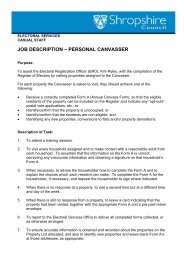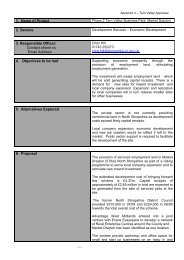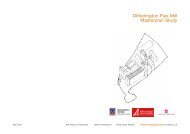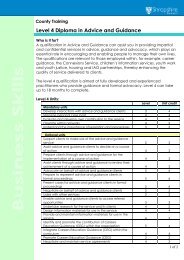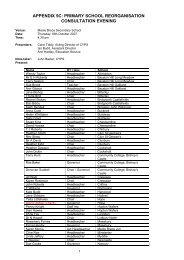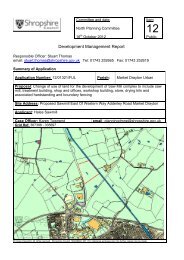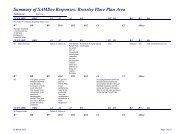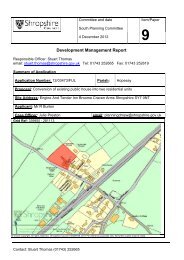8 Shropshire Council Quarter 1 Performance.pdf
8 Shropshire Council Quarter 1 Performance.pdf
8 Shropshire Council Quarter 1 Performance.pdf
Create successful ePaper yourself
Turn your PDF publications into a flip-book with our unique Google optimized e-Paper software.
Scrutiny: 21 st October 2009; <strong>Shropshire</strong> <strong>Council</strong> <strong>Performance</strong> report <strong>Quarter</strong> 1 2009/10<br />
Committee and Date<br />
Cabinet 23 rd September papers<br />
due 15 th September 2009<br />
Scrutiny 21 st October papers<br />
due 9 th October 2009<br />
Item/Paper<br />
8<br />
SHROPSHIRE COUNCIL PERFORMANCE REPORT QUARTER ONE<br />
2009/10<br />
Summary<br />
Responsible Officer Wendy Marston – Head of <strong>Performance</strong> and Communications<br />
e-mail: wendy.marston@shropshire.gov.uk Tel: (01743) 252004 Fax (01743) 252827<br />
This report provides details of the quarter one performance for <strong>Shropshire</strong> <strong>Council</strong> Corporate<br />
Plan 2009/10. Overall the performance of the Corporate Plan has met target in quarter<br />
one.<br />
Recommendations<br />
A. That Scrutiny note the quarter one performance for <strong>Shropshire</strong> <strong>Council</strong> Corporate<br />
Plan.<br />
B. That Scrutiny note the exception report (Appendix A) for <strong>Shropshire</strong> <strong>Council</strong><br />
Corporate Plan.<br />
C. That Scrutiny note the following action plans which have been produced to address<br />
under performance in the following areas:<br />
i. Children's Social Care Assessment Processes (Appendix B),<br />
ii. Housing – rent collection (Appendix C),<br />
iii. Planning applications (Appendix D).<br />
Background<br />
1. Section four of the Corporate Plan contains performance indicators which are<br />
grouped under the aims and priorities for <strong>Shropshire</strong> <strong>Council</strong>. These performance<br />
indicators are measured on a quarterly basis and are used to inform the quarterly<br />
reporting and to therefore summarise the overall performance of <strong>Shropshire</strong><br />
<strong>Council</strong> Corporate Plan 2009/10.<br />
2. The LAA indicators for which <strong>Shropshire</strong> <strong>Council</strong> is directly responsible are<br />
included within the Corporate Plan and are therefore monitored as part of this<br />
report. The entire LAA is monitored through a separate performance report which<br />
is agreed and signed off by the Leadership Board. (This can be obtained from the<br />
Policy and <strong>Performance</strong> team if required).<br />
3. The Improvement Plan within the Corporate Plan focuses on the most significant<br />
areas for improvement for the <strong>Council</strong>. These are either linked to the corporate<br />
priorities or based on findings from external inspection or internal review. Progress<br />
against the Improvement Plan will be reported at quarter two.<br />
4. The corporate performance management system <strong>Performance</strong>Plus is used to<br />
collect and report performance information across the council. There are four<br />
symbols used to explain performance:<br />
performance has exceeded target by +5%,<br />
performance has exceeded target by between 0% and +4.99%<br />
performance has missed target by between 0.01% and 4.99%<br />
performance has missed target by 5% or more.<br />
Contact: Wendy Marston – (01743) 252004 1
Scrutiny: 21 st October 2009; <strong>Shropshire</strong> <strong>Council</strong> <strong>Performance</strong> report <strong>Quarter</strong> 1 2009/10<br />
<strong>Shropshire</strong> <strong>Council</strong> <strong>Performance</strong> Summary 2009/10<br />
5. Overall performance for <strong>Shropshire</strong> <strong>Council</strong> Corporate Plan 2009/10 has met<br />
target . <strong>Performance</strong> at quarter one has been reported for 68 of the 110<br />
measures included. Of those reported against target, 37 indicators (67%) have met<br />
target , seven indicators (12%) are less than 5% from target and 11 indicators<br />
(21%) have missed target . A further 13 indicators have been reported but no<br />
target has yet been agreed.<br />
6. The performance of the four corporate aims and corporate priorities is as follows<br />
a. Aim 1 “to give children & young people the best opportunities today and for<br />
the future” has missed target.<br />
b. Aim 2 “to improve the health & well-being of <strong>Shropshire</strong>’s residents” has<br />
achieved target.<br />
c. Aim 3 “to ensure safe & strong communities for everyone in the county” has<br />
achieved target.<br />
d. Aim 4 “to build sustainable communities for local people to live and work in<br />
<strong>Shropshire</strong>” has achieved target.<br />
e. Corporate Health has missed target.<br />
7. Overall there are 18 indicators which have missed target at quarter one, details of<br />
which can be found below under the relevant aim and in the exception report<br />
appendix A.<br />
8. <strong>Shropshire</strong> reported 38 national indicators to the Price Waterhouse Coopers<br />
(PWC) benchmarking club in quarter one, of which 60% (23 indicators) are in the<br />
top two quartiles. This is well above average and ranks <strong>Shropshire</strong> 5 th overall out<br />
of 26 unitary councils in the benchmarking club, which as a newly formed unitary<br />
authority is an excellent starting position.<br />
Place Survey Results 2008/09<br />
9. The final results of the Place Survey were published in June 09. Overall,<br />
<strong>Shropshire</strong>'s performance on questions based on satisfaction with place is<br />
positive. The results of the survey show 87.5% of respondents said they were<br />
satisfied with their local area as a place to live compared to the national average of<br />
80%.<br />
10. The Place Survey results inform 18 of the National Indicators, five of which are<br />
measured as part of the Corporate Plan. These are discussed in more detail within<br />
Aim 3.<br />
11. The 2008/09 Place Survey was undertaken prior to the creation of the new<br />
<strong>Shropshire</strong> <strong>Council</strong>. Residents were asked for their views on “<strong>Shropshire</strong> County<br />
<strong>Council</strong> and your local District <strong>Council</strong>” as part of the survey. Results therefore are<br />
only indicative of views for the new <strong>Shropshire</strong> <strong>Council</strong>.<br />
12. Overall satisfaction for the <strong>Council</strong> was not reported by CLG but Ipsos MORI (who<br />
conducted the survey for <strong>Shropshire</strong>) report the result at 42%, which is a decline<br />
from 2006/07 average for all the <strong>Shropshire</strong> authorities of 55%. Nationally, the<br />
results for this indicator show a decline. The national average for 2006/07 was<br />
51% and this has fallen to 45.4% in 2008/09. It is concerning that 24% of residents<br />
said they were dissatisfied with how their council runs things.<br />
Aim 1 “to give children & young people the best opportunities today and for the<br />
future”<br />
13. The top priority under this aim - “support vulnerable children and young people to<br />
improve their life chances” (priority 2) has met target. Other key areas of focus<br />
within this aim include reducing homelessness amongst young people, children’s<br />
safeguarding and improving educational attainment.<br />
Contact: Wendy Marston – (01743) 252004 2
Scrutiny: 21 st October 2009; <strong>Shropshire</strong> <strong>Council</strong> <strong>Performance</strong> report <strong>Quarter</strong> 1 2009/10<br />
14. Priority 2 “Support vulnerable children and young people to improve their life<br />
chances” is a top priority for <strong>Shropshire</strong> council and whilst overall this has met<br />
target, four of the six indicators have missed target. Placement stability and<br />
children’s social care assessments were subject to exception reports in 2008/09<br />
and improvements in performance have been seen. However, performance has<br />
not improved sufficiently to achieve the targets set and an action plan is therefore<br />
attached (appendix B).<br />
15. Placement stability forms part of the corporate improvement plan specifically to<br />
provide an “increase in, and diversification of, placement provision for Looked After<br />
Children, by increasing the number and skill levels of foster carers and improving<br />
the support available to them”. Progress against this will be measured and<br />
reported at quarter two.<br />
16. Homelessness amongst young people (priority 1) has met target. However, within<br />
this aim care leavers in suitable accommodation (NI147) has missed target each<br />
quarter since June 2008. <strong>Performance</strong> has now fallen from 2nd quartile to bottom<br />
quartile in the PWC benchmarking club. The nature of this indicator means that it<br />
is very much affected by small numbers (current performance relates to just five<br />
people) and further commentary to explain underperformance can be found in the<br />
exception report (appendix A).<br />
17. NI117 -16 to 18 year olds who are not in education, employment or training<br />
(NEET) within priority 4 has again missed target despite the action plans in place.<br />
This indicator forms part of the LAA and is being closely monitored by the<br />
Leadership Board and as a result we can demonstrate the following outcomes:<br />
Not in Education Employment or Training NEET<br />
A meeting is being convened between the County, LSC and providers of post 16 opportunities to look<br />
at ways of addressing this issue. Team Action Plans are currently being updated and discussions in<br />
the regular 14-19 Forums are identifying ways that other local partners can support actions to reduce<br />
NEETs. Previous action taken has had a positive impact on local young people:<br />
Through targeted activity we have :<br />
Supported 15 teenage mothers back into learning;<br />
Engaged 40 young people, promoting ongoing learning and access to higher education as a<br />
progression route<br />
Supported 50 young offenders into EET through a range of bespoke mentoring/support packages.<br />
Supported over sixty young people who have barriers to accessing EET in hot spot areas have<br />
accessed programmes of Life Skill and Job Clubs and this has been a successful way of<br />
supporting their transition into full-time EET.<br />
The ongoing work as a results of targeted action plans means that:<br />
100% of schools have identified as a target there are measures in place to identify those young<br />
people who are potential NEET and have strategies in place to meet their needs.<br />
Dialogue with the LSC is routine to achieve the September Guarantee by the end of September<br />
each year to ensure that there is sufficient appropriate provision to meet the demands of the 16-18<br />
cohort. Level of provision against offers is good at present.<br />
We are working towards agreeing a protocol for the involvement of <strong>Shropshire</strong> <strong>Council</strong> in the<br />
provision of work experience and work placements, that target the most vulnerable i.e. LLDD and<br />
looked after children. Working with a range of partners in the public sector, work placements are<br />
made available for young people within these organisations (work experience, job tasters,<br />
apprenticeships and employment opportunities). Partners in the public sector, e.g. the PCT, have<br />
identified some agreed actions including a series of awareness raising sessions for key people<br />
involved in recruitment.<br />
Over the previous quarter a number of innovative activities have been introduced to meet the needs of<br />
this client group. These have included the VProgramme, teenage parents programme, Life Skill<br />
Contact: Wendy Marston – (01743) 252004 3
Scrutiny: 21 st October 2009; <strong>Shropshire</strong> <strong>Council</strong> <strong>Performance</strong> report <strong>Quarter</strong> 1 2009/10<br />
provision in Ludlow in collaboration with Ludlow College and job club activity.<br />
Aim 2 “to improve the health & well-being of <strong>Shropshire</strong>’s residents”<br />
18. The top priorities in this aim are “improve the housing delivery for which<br />
<strong>Shropshire</strong> <strong>Council</strong> has direct responsibility” (priority 5) and “Maximise vulnerable<br />
and older people’s income and increase take up of benefits” (priority 8).<br />
19. Priority 5, the top housing priority “improve the housing delivery for which<br />
<strong>Shropshire</strong> <strong>Council</strong> has direct responsibility” has missed target. Only one local<br />
indicator has been reported against target this quarter, “% of rent due as the % of<br />
rent collected” which has missed target. Work is underway to ensure that all<br />
Housing Benefit due to the Landlord is credited to the appropriate account, and to<br />
ensure that all cash collected within each quarter is credited to the correct account<br />
in a timely manner. As housing is a key front line service, a detailed progress<br />
report is attached (appendix C).<br />
20. Work around tenant satisfaction is ongoing and although the figures are measured<br />
annually the housing team are monitoring activities and measuring the<br />
achievements around opportunities for participation. Work also continues in<br />
partnership to deliver an effective adaptations service and the performance will be<br />
reported against target at quarter two.<br />
21. The adult social care measures within priorities 6 and 7, both national and local,<br />
have performed well and the local indicators in particular have shown improvement<br />
on quarter four 2008/09. This will contribute to the Transforming Social Care Policy<br />
agenda, which highlights the need to provide a greater personal choice and control<br />
for older service users. The actions against this, including working with partners to<br />
develop a greater range of support providers, will be monitored as part of the<br />
Improvement Plan.<br />
22. The four local measures around adult protection cases have improved noticeably<br />
from the previous quarter. There are two adult social care indicators which have<br />
just missed target; timeliness of social care packages (NI135) and carers receiving<br />
needs assessments (NI136). Although work continues to improve these indicators<br />
NI135 remains in the bottom quartile. The exercise of giving one off payments to<br />
carers will be re-run again later in 2009/10 to achieve the end of year target.<br />
Further details of planned actions can be found in appendix A.<br />
23. NI145 (adults with learning disabilities in settled accommodation) has not been<br />
reported against target but performance remains well within the PWC top quartile.<br />
This is a new national indicator and the definition changed towards the end of<br />
2008/09 so targets for 2009/10 will be set in quarter three once a full year’s data<br />
has been recorded. The impact our support services can have for vulnerable<br />
people in <strong>Shropshire</strong> is highlighted in the following case study:<br />
Housing Services<br />
New Century Court (NCC) is a housing facility where the council supports 16-25 year olds from all<br />
kinds of different backgrounds.<br />
When Emma started at New Century Court she had many issues. She was extremely vulnerable<br />
because of her learning difficulties and a turbulent family history. Staff worked with her on all aspects<br />
of her life that she needed help with, isolating salient issues via her support plan. It was a long<br />
process but staff worked on her confidence, personal hygiene, budgeting and life skills and<br />
eventually Emma gained work locally and moved into the semi independent move-on flat.<br />
While still a resident at NCC, Emma represented Great Britain at the special Olympics in China and<br />
won 3 gold medals and a silver. This was an unbelievable achievement for someone who a year<br />
previous had struggled with any interaction with other people. Emma is now living independently and<br />
working locally. Staff still support Emma but see her less and less because her confidence is<br />
Contact: Wendy Marston – (01743) 252004 4
Scrutiny: 21 st October 2009; <strong>Shropshire</strong> <strong>Council</strong> <strong>Performance</strong> report <strong>Quarter</strong> 1 2009/10<br />
growing daily.<br />
24. The benefits take up indicators (priority 8) are newly reported for <strong>Shropshire</strong><br />
<strong>Council</strong> and have all shown good performance in line with end of year targets. This<br />
good performance will support the Improvement Plan which aims to ensure<br />
“residents can live comfortably and have the income that they are eligible to”.<br />
25. “Promote opportunities for residents to lead active lives and enjoy their free time”<br />
(priority 9) has exceeded target due to the performance of the two culture and<br />
leisure indicators “volunteers developing/ delivering culture and outdoor recreation<br />
services” and “number of community learning opportunities for older people.”<br />
26. Children and young people’s satisfaction with parks and open spaces (NI199) is<br />
measured as part of priority 9 and although reported at quarter four there was no<br />
target set. However, the result fell within the PWC bottom quartile. The Place<br />
Survey measures residents’ satisfaction with parks and open spaces and the result<br />
achieved a low ranking, falling within the 3 rd quartile nationally. The Improvement<br />
Plan shows there is an awareness of these low satisfaction levels and actions to<br />
improve are in place to improve access to leisure facilities.<br />
Aim 3 “to ensure safe & strong communities for everyone in the county”<br />
27. This aim has exceeded target and contains top priority 13 “give communities more<br />
of a say in service delivery, recognise and respect differences”. All of the indicators<br />
reported against target within the aim have either met of exceeded target<br />
28. The Place Survey shows resident perceptions exclusively showing satisfaction<br />
levels in the second and top quartile for indicators covered by priority 13, as shown<br />
in the table below:<br />
29. There has been a decline in the percentage of people who feel that they can<br />
influence decisions in their local area (NI 4); the figure of 29.5% is slightly higher<br />
than the national average although it is 6.5% down against our 2006/07 result.<br />
30. It is recommended that the Citizen’s Panel is used to review the Place Survey<br />
results in greater depth, examining overall satisfaction, dissatisfaction and<br />
influencing local decisions.<br />
31. “Minimise the harm caused by drug and alcohol misuse” priority 12 has exceeded<br />
target due to the result for the rate of hospital admissions per 100,000 for alcohol<br />
related harm (NI039). This has performed better than target and <strong>Shropshire</strong> is one<br />
of only three authorities in the West Midlands whose results indicate a less steep<br />
rise than predicted. Below is an example of the impact services are having with<br />
young people to achieve this outcome.<br />
Contact: Wendy Marston – (01743) 252004 5
Scrutiny: 21 st October 2009; <strong>Shropshire</strong> <strong>Council</strong> <strong>Performance</strong> report <strong>Quarter</strong> 1 2009/10<br />
<strong>Shropshire</strong> DAAT Young People & Alcohol Partnership Project<br />
The <strong>Shropshire</strong> DAAT Young People & Alcohol Partnership Project works through the<br />
identification of geographical ‘hotspots’ where young people and alcohol is a particular issue. and<br />
the delivery of a co-ordinated partner agency response to this issue. Through 2008/09<br />
consultation took place in each of the 5 hotspot areas, Ludlow, Oswestry, Bridgnorth, Market<br />
Drayton and Shrewsbury with 3,631 young people taking part. Through 2009, each of the area<br />
steering groups are implementing improvement plans, e.g. in Market Drayton will engage The<br />
Grove School Peer Mentoring Project as well as through PHSE lessons to increase awareness of<br />
safe drinking limits and general alcohol awareness for young people; Ludlow and Bridgnorth are<br />
planning specific projects around drink driving and sexual behaviours to be delivered through the<br />
youth service and the schools CHAT service.<br />
Results from work undertaken so far includes:<br />
A ‘Lets Talk About Drink’ booklet, aimed at parents of 8 – 12 year olds, was distributed to a total of<br />
15,680 pupils. A number of booklets included returnable evaluation questionnaires. In response to the<br />
question ‘Did it change your attitude towards alcohol’? a number of parents answered ‘Yes’ and gave<br />
the reasons:<br />
The units per adult were interesting.<br />
Because it can cause more health problems than I thought.<br />
I was already pretty aware of limits etc, but this exercise reinforced that, showed me how close I<br />
was to the limits.<br />
Made me think about how much I am drinking and the measurements.<br />
Made me more aware of how to tell my children and to learn more about alcohol and the<br />
dangers.<br />
Parents also commented that on the booklet:<br />
Useful tool for discussing alcohol with children<br />
We found it very good and it opened the kid’s eyes and minds to the problems of alcohol.<br />
Very informative.<br />
We enjoyed sharing this activity which we found easy as were an open ‘talky’ family.<br />
One young person, aged 14, who attended a “Shiftys Alcohol Awareness session” said “the session<br />
has changed how I feel, I’ve now stopped binge drinking”.<br />
40 young people aged 16-25, attended Drive events in Oswestry. After attending the Petrol & Alcohol’<br />
Drink Drive VJ Project, a 17 year old male said “The effect this project has on me is the seriousness<br />
of drink driving – the crash reconstruction was a life changing experience because it looked so real’.<br />
After the Bridgnorth Friday Evening Detached Youth Project, the Bridgnorth Town Local Police Officer<br />
said he has seen “a reduction in complaints for youth street drinking in the town centre – the team are<br />
doing a good job in engaging with young people”.<br />
Aim 4 “to build sustainable communities for local people to live and work in<br />
<strong>Shropshire</strong>”<br />
32. The top priorities in this aim are “Reduce the levels of worklessness and support<br />
economic prosperity” (priority 16) and “Value and improve <strong>Shropshire</strong>’s<br />
environment” (priority 18).<br />
33. The number of households living in temporary accommodation (NI156) sits under<br />
priority 14 and has exceeded target. The other housing indicators regarding net<br />
additional homes provided and supply of ready to develop housing sites will be<br />
measured annually. However, as affordable housing is a key issue for <strong>Shropshire</strong><br />
<strong>Council</strong> there are actions in the Improvement Plan to the availability of homes<br />
across <strong>Shropshire</strong> and this will be reported at quarter two.<br />
Contact: Wendy Marston – (01743) 252004 6
Scrutiny: 21 st October 2009; <strong>Shropshire</strong> <strong>Council</strong> <strong>Performance</strong> report <strong>Quarter</strong> 1 2009/10<br />
34. “Value and improve <strong>Shropshire</strong>’s environment” (priority 18) has missed target<br />
because the four planning indicators reported have not met target. The integration<br />
of data and systems to the central validation team and the implementation of the<br />
new Land and Property IT system has led to initial underperformance in validating<br />
new applications. There are however additional resources and improvements<br />
being implemented (further details can be found in appendix A). A detailed<br />
progress on the process to improve the planning applications is attached<br />
(appendix D).<br />
35. To “reduce the levels of worklessness and support increased economic prosperity”<br />
priority 16 is a top priority and economic development is a key issue for <strong>Shropshire</strong><br />
<strong>Council</strong> and the <strong>Shropshire</strong> Partnership. They are working to ensure that the<br />
impact of the economic downturn is minimised within <strong>Shropshire</strong> as discussed in<br />
the following case study:<br />
Growth and sustainability of businesses<br />
The Economic Development Team has supported the <strong>Council</strong>’s bid with local colleges and<br />
Universities to the Higher Education & Funding <strong>Council</strong> to improve the HE offer in <strong>Shropshire</strong>. A<br />
statement of intent was submitted in June, which we hope will lead to being invited to submit a full<br />
bid. The proposals should have the impact of creating a better skilled workforce in the county to fulfil<br />
the requirements of businesses and generate and retain more graduates in the county. The impact<br />
should be better qualified staff, capable of commanding higher wage levels. The Invest In <strong>Shropshire</strong><br />
initiative directs businesses to appropriate sources of support to increase their growth prospects,<br />
increase their profitability which should impact on wage levels. The focus is on encouraging high<br />
growth sectors, such as creative industries and environmental technologies, which attract well<br />
qualified staff with higher earning potential.<br />
The Re:think initiative supports businesses to diversify in to environmental technologies and exploit<br />
new “green” markets, improving both the environmental and financial sustainability of businesses<br />
(e.g. plumbers trained in solar panel installation). A bid to further support the growth of the<br />
environmental technology sector in <strong>Shropshire</strong> (Re:think 2, submitted by the Economic Development<br />
Team) is awaiting approval by Advantage West Midlands following a review of their budget and<br />
prioritisation exercise.<br />
36. Two of the eight performance indicators for priority 16 have so far been reported<br />
against target. The number of disabled people supported into employment has met<br />
target due to the support they have received. The number of apprenticeships has<br />
exceeded target, despite the economic downturn.<br />
Corporate Health<br />
37. The sickness indicator (BV12) measures the days lost due to sickness. The result<br />
of 7.38 days means the quarter one target of 7.97 days has been exceeded and<br />
this is an improvement on quarter one 2008/09 when the result was 8.37 days.<br />
38. The percentage of employees with a disability and the percentage of employees<br />
from minority ethnic communities have both just missed target. Further details are<br />
contained in appendix A. However with the recent changes to the workforce the<br />
impact on these figures was expected.<br />
39. The number of Equality Needs Impact Assessments (EINAs) completed has also<br />
underperformed for the 4 th consecutive quarter and details of the current<br />
underperformance are contained in appendix A.<br />
40. The new complaints system is now in place meaning that we are able to monitor<br />
our complaints and act on them on a regular basis. This is demonstrated by the<br />
following:<br />
Contact: Wendy Marston – (01743) 252004 7
Scrutiny: 21 st October 2009; <strong>Shropshire</strong> <strong>Council</strong> <strong>Performance</strong> report <strong>Quarter</strong> 1 2009/10<br />
Complaints and improved access for planning applications.<br />
Comments were received from customers about the poor location and lack of accessibility in terms<br />
of time and viewing facilities of the planning service facility within the Revenues and Benefits<br />
reception area. The reception did not have adequate amenities to allow customers to view planning<br />
applications and the associated plans. This has meant that the Planning Service has reviewed the<br />
arrangements.<br />
In order to make accessibility easier the facility has been moved to the main reception in Shirehall,<br />
with large desks for paper plans and PC's for online viewing being available for the public.<br />
There have been no further complaints since the changes to access have been done.<br />
List of Background Papers (This MUST be completed for all reports, but does not<br />
include items containing exempt or confidential information)<br />
<strong>Shropshire</strong> <strong>Council</strong> Corporate Plan 2009/13<br />
Human Rights Act Appraisal<br />
The recommendations in this report are compatible will provisions of the Human Rights Act<br />
1998.<br />
Environment Appraisal<br />
n/a<br />
Risk Management Appraisal<br />
n/a<br />
Community / Consultations Appraisal<br />
n/a<br />
Cabinet Member<br />
Cllr. Peter Nutting<br />
Local Member<br />
All<br />
Appendices<br />
Appendix A – Corporate Plan exception report<br />
Appendix B – Children's Social Care Assessment Processes<br />
Appendix C – Housing – rent collection<br />
Appendix D – Planning applications<br />
Contact: Wendy Marston – (01743) 252004 8



